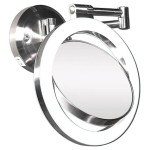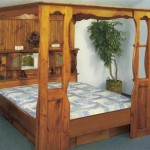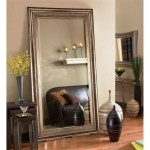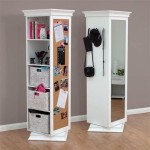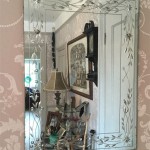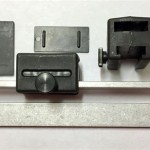How To Remove A Wall Mirror That Is Glued On
Removing a glued-on wall mirror requires careful planning and execution to prevent damage to the wall and the mirror itself. Different methods are available depending on the type of adhesive used and the desired outcome regarding the mirror's reusability.
Before beginning any removal process, gather the necessary tools. These may include heavy-duty gloves, safety glasses, a drop cloth, putty knife or paint scraper, razor blades, duct tape, various wires (piano wire, fishing line, or picture hanging wire), a heat gun or hairdryer, hammer, pry bar, solvent (such as rubbing alcohol or adhesive remover), and patching supplies (spackle, drywall compound).
The first step is to protect the surrounding area. Lay down a drop cloth to catch any falling debris or adhesive. Using duct tape, create a starburst pattern on the mirror's surface. This helps prevent shattering and keeps the pieces together if the mirror cracks during removal. Wearing safety glasses and heavy-duty gloves is crucial for protection against sharp edges and chemicals.
Several removal methods can be employed, beginning with the least invasive. One such method involves using a thin, sharp object like a razor blade or putty knife to work behind the mirror. Start at a corner or edge where the adhesive bond might be weaker. Gently insert the blade and attempt to slice through the adhesive. Fishing line, picture hanging wire, or piano wire can also be used in a sawing motion to cut through the adhesive. If the mirror is small and the adhesive isn't exceptionally strong, this method might suffice.
If the adhesive proves more resistant, heat can be applied to soften it. A hairdryer or heat gun can be used, directing the heat at the back of the mirror. Keep the heat moving to avoid concentrating it in one spot, which could crack the mirror. As the adhesive softens, try using the putty knife or wire again to pry or saw the mirror away from the wall.
For larger mirrors or more stubborn adhesives, a combination of heat and leverage may be necessary. After heating the adhesive, carefully insert a thin pry bar behind the mirror. Gently apply pressure to pry the mirror away from the wall. Work slowly and incrementally to minimize damage. Wooden shims can be inserted as the mirror is pried away to maintain separation and prevent the adhesive from re-bonding.
If the mirror is still firmly attached, a more aggressive approach might be required. This involves using solvent to weaken the adhesive. Before using a solvent, test it in an inconspicuous area to ensure it doesn't damage the wall's finish. Apply the solvent to the edges of the mirror and allow it to penetrate behind the mirror. This may require multiple applications. Once the adhesive is sufficiently weakened, attempt to pry the mirror off the wall.
After removing the mirror, adhesive residue will likely remain on the wall. Depending on the adhesive type, different removal methods are suitable. For some adhesives, rubbing alcohol or specialized adhesive removers can be effective. Apply the solvent to a cloth and rub the affected area. For more stubborn residue, a scraper may be necessary.
Once the adhesive residue is removed, the wall may require patching. Fill any holes or imperfections with spackle or drywall compound. Allow the compound to dry completely, then sand it smooth and prime before repainting or applying a new wall covering.
The specific method for removing a glued-on mirror depends on several factors, including the size and weight of the mirror, the type of adhesive used, and the desired outcome for both the mirror and the wall. Careful consideration of these factors will determine the most appropriate course of action.
Different types of adhesives require different approaches. For example, construction adhesive requires a more aggressive approach compared to double-sided tape. Identifying the type of adhesive used can inform the removal strategy. If uncertain, starting with the least invasive method and gradually increasing the intensity is recommended.
Throughout the entire removal process, prioritize safety. Wear appropriate protective gear, and work slowly and deliberately to minimize the risk of injury or damage. If the mirror is particularly large or heavy, seeking professional assistance is advisable.
Proper disposal of the mirror and any materials used in the removal process is essential. Broken mirror pieces should be carefully wrapped and disposed of according to local regulations. Chemical solvents should be handled and disposed of according to their instructions.
Maintaining a clean and organized workspace throughout the process helps prevent accidents. Proper ventilation is crucial, especially when using solvents or heat. Keeping the work area free of clutter also facilitates a smoother removal process.

How To Remove A Mirror Glued The Wall Forbes Home

How To Remove A Wall Mirror 11 Steps With Pictures Wikihow

How To Remove A Wall Mirror 11 Steps With Pictures Wikihow

How To Safely And Easily Remove A Large Bathroom Builder Mirror From The Wall Site Title

How To Remove A Bathroom Mirror Lowe S

How To Remove A Wall Mirror Diy Weekend Project Collage Lighted

How To Remove A Wall Mirror 11 Steps With Pictures Wikihow

How To Remove A Large Mirror That S Glued The Wall Emerging Home

How To Safely And Easily Remove A Large Bathroom Builder Mirror From The Wall Site Title

How To Remove A Bathroom Mirror Lowe S

